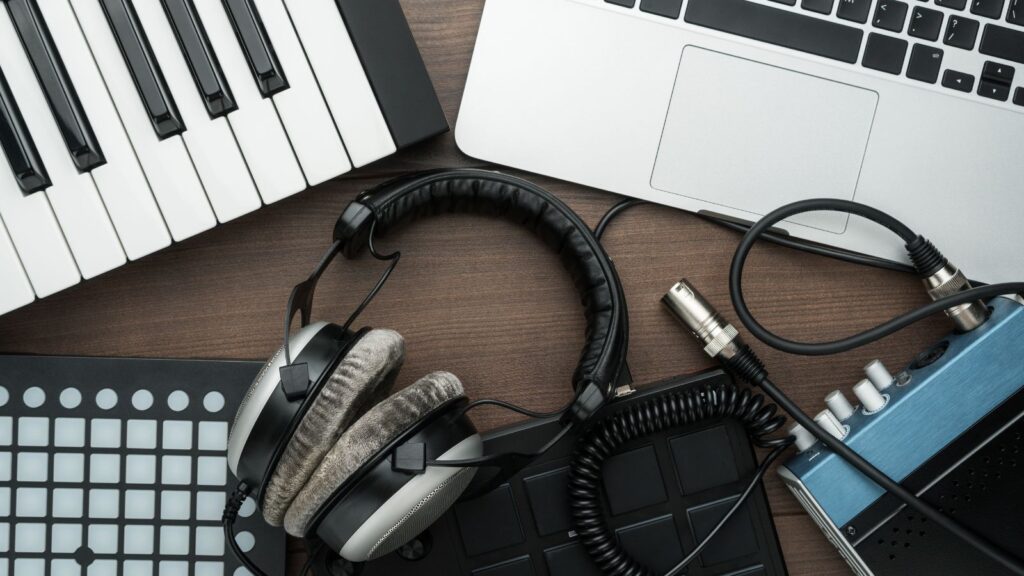In the pulsating world of music production, the right equipment can transform a simple melody into a symphony. It’s a realm where technology and creativity intertwine, elevating sounds to new heights. This article will delve into the essentials of Music Production Equipment, providing a roadmap for both budding and seasoned producers.
From mixing boards to microphones, synthesisers to software, the landscape of Music Production Equipment is vast and varied. Whether you’re setting up a home studio or looking to upgrade your gear, understanding the role of each piece is pivotal. So, let’s embark on this sonic journey, exploring the tools that bring music to life.
Music Production Equipment
Quality reigns supreme in any endeavour, with music production being no exception. Precision, clarity, and enhancement of sounds stand as primary by-products of quality Music Production Equipment. Noteworthy music equipment contributes fundamentally to the final output, cultivating an environment conducive to creativity.
Music software forms an integral part of this ecosystem. High-grade ones, like Digital Audio Workstations (DAWs), offer extensive capabilities to manipulate sounds as per a producer’s vision. Such top-tier software provide myriad options to add effects, mix multiple tracks together and perform other tasks that immensely enhance the final audio piece.
Working with top-of-the-line recording equipment also brings an unmatched level of professionalism. The influence of robust hardware, in combination with precision-crafted software, results in a final product that attracts listeners’ attention. Example being high-fidelity headphones, they provide a described audio experience, unmasking every delicate detail present in the audio track.
Moreover, every piece of quality equipment communicates a different story. A quality synthesiser, with its vast sound palette, provides unlimited possibilities for creating unique sounds, contributing a distinct character to the track.
Put simply, investing in quality Music Production Equipment is not an expense, but a judicious investment. It’s not just about making sounds but making them resonate, giving life to the music. Equipment reliability, synonymous with quality, provides assurance during live performances, where there’s no room for failing hardware.

Music Production Equipment Essentials
While focused on the influence of top-grade Music Production Equipment, one encounters several essentials. Outfitting your studio with these items intensifies both sound quality and artistic capabilities.
The Digital Audio Workstation (DAW) ranks highest on the list. Many professionals exploit software like Pro Tools and Logic Pro for its diverse sound arrangement features. DAWs provide unmatched flexibility by furnishing an integrated platform for recording, editing, and mixing sounds.
Microphones, next in line, are imperative for capturing crisp, clear sounds. XLR microphones, for instance, are cherished for their broader frequency response and lower noise. They’re a favourite among professionals for their proficiency in capturing both vocal subtleties and instrumental nuances.
High-fidelity headphones follow close, crucial for monitoring sounds. Offering unparalleled sound isolation, headphones like the Sony MDR-7506 aid in identifying disparities in frequencies – an essential feature during sound production and mixing.
Synthesisers too gain traction in this arena. They allow the creation of original sounds, offering an array of musical selection capabilities. Models like the Yamaha Montage 8 prove desirable for their luxury of integrating and manipulating digital and analog sounds.
Lastly, audio interfaces make the list. They essentially bridge the gap between the audio sources and your DAW. Producing high-resolution sounds, they aid in effective sound transmission. The Focusrite Scarlett 2i2 stands popular, known for its low latency performance.

Buying Advice for Music Production Equipment
In the purchase of Music Production Equipment, key considerations lie in the purpose, budget, and sound quality. For each type of gear, evaluate its specific use in your production setup. Microphones, for instance, serve numerous roles in music production, from recording vocals to capturing instrumental sounds. High-quality models, like condenser microphones, afford clear and detailed audio capture, fostering improved sound generation.
The budget, however, plays a vital role, especially for beginners delving into music production. Opting for budget-friendly but effective DAWs, such as GarageBand for Apple users, provides an avenue for mastering sound arrangement before upgrading to high-end versions like Ableton Live or Logic Pro.
Next, consider the sound quality; how the equipment influences audio production. High-fidelity headphones, for example, deliver reliable sound that empowers music producers to monitor and accurately mix tracks.
However, buying high-grade Music Production Equipment involves retrospective planning. It’s worthwhile to repeatedly evaluate and upgrade the setup, ensuring each addition significantly betters the overall sound output. For example, purchasing an audio interface amplifies the quality and clarity of sound transmission.

